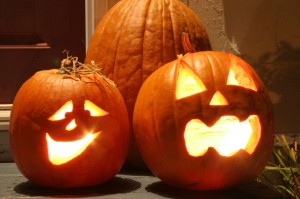The Origin o’ the Jack-o’-lantern

Jack-o’-lanterns are hollowed-out pumpkins with a face cut into one side. Most jack-o’-lanterns contain a candle or some other light. Many people display jack-o’-lanterns on Halloween.
Art Explosion
Pumpkins with toothy smiles on porches are a tell-tale sign of autumn and a common decoration for Halloween. Pumpkins transform into jack-o’-lanterns when the seeds are scraped out, faces are carved into the fruit on one side, and a candle or other light is set inside the pumpkin. Why do we hollow out these fruits and set them outside to rot? Why do we call them jack-o’-lanterns? While jack-o’-lanterns have become a well-known tradition, the origin of the jack-o’-lantern is still disputed (argued).
Irish folklore features a story about a man named Stingy Jack. Stingy Jack makes several deals with the devil, including that the devil cannot claim his soul when he dies. After years of tricking the devil, Stingy Jack dies. Heaven rejects him and the devil maintains his word and does not accept him in hell either. Stingy Jack is given one piece of coal which he puts in a carved-out turnip to light his way as he wanders the land forever.
Many people in Ireland believed they saw Stingy Jack when they saw ghost lights, or ignis fatuus, at night. Ignis fatuus, also known as foolish fire, jack-o’-lantern, and will-o’-the-wisp, is a phenomenon where decaying plants in marshes (swamps) produce methane and other compounds which burn and emit a blue glow. This process is called oxidation. People said ignis fatuus was Stingy Jack walking through the night. The term Jack of the lantern was shortened to jack-o’-lantern over time. The story of Stingy Jack explains ignis fatuus just like many myths and folktales explain natural phenomena.

On Halloween, many people decorate their homes with jack-o’-lanterns, hollowed-out pumpkins with a face cut into one side. A candle or other light illuminates the face from within, as seen in this photograph.
© V. J. Matthew, Shutterstock
In Ireland and Scotland, people began carving faces into turnips and potatoes. They would set them in windows and outside houses to ward off Stingy Jack and other ghosts. In England, people often used beets. These root vegetables with ghoulish faces are usually set out on All Hallow’s Eve. All Hallow’s Eve was eventually shortened to Halloween. Halloween developed from a Celtic festival over 2,000 years ago in the area that is now the United Kingdom, Ireland, and northwestern France. The festival was called Samhain, which means summer’s end. It was celebrated around November 1. In the 800′s, the Christian church established All Saints’ Day on this date. All Saints’ Day was also called All Hallows’. Hallow means saint, or one who is holy.
When many Irish immigrants established themselves in the United States, they brought along the tradition of jack-o’-lanterns. Seeing there were not as many turnips in the United States as there were in Ireland, pumpkins quickly became a perfect alternative for the tradition. Jack-o’-lanterns were also popularized by Washington Irving’s The Legend of Sleepy Hollow (1848), in which a headless horseman throws a pumpkin at a man who believes the pumpkin is the horseman’s head. Now jack-o’-lanterns are illuminated on Halloween, the last night of October, continuing a long tradition of warding off ghosts in festive, fall fashion.


